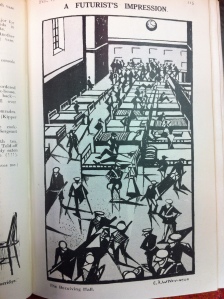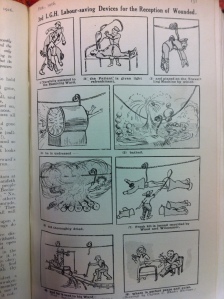The March issue of the Sir Walter St John’s School Magazine was a Special War Number. This stemmed from the boys in the school attempting to get in touch with all the old doys on active service so that they could send them a Christmas greeting and some cigarettes, resulting in a selection of the letters home in response being selected for publication.
The cigarettes were gratefully received, one old boy writing that they “arrived at an opportune moment. I was in the trenches and had run out of tobacco – a greater calamity than an attack”. Several of the old boys had come across each other in neighbouring battalions, although some had more unusual meetings:
One night, on sentry duty, outside a war-demolished mansion, I discovered a garden filled with choicest fruit. Against the rules, I ventured in and by the light of a match filled by pockets, when I was surprised by a slight rustle. A German! I thought at once; or perhaps a rat. To be astonishment, however, it turned out to be one of my old Sir Walter St John’s School friends…
Several described life in the trenches, including the phrase “We sit in mud, sleep in mud, and eat mud”, whilst others were currently billeted behind the lines, or elsewhere round the world:
As I pencil this note I am smoking one of the cigarettes in my billet, within sound of the guns…
We have just come out of the trenches for a fortnight’s rest in a small village not more than three miles from the line. Unlike most villages round here it has not suffered in any way from bombardment, but jogs its way along seemly oblivious of the ruins all around. The women here especially are very active, nearly all the farm work being in their hands… The slightest noise from the lines can be heard distinctly. We heard a bugle band recently that was playing three or four miles behind the Huns’ lines…
Your kind packet was forwarded me from Fort William, where we were stationed for 13 months. I cannot say how long we shall be at Lucknow, but expect before very long to go to the Gulf, where things are pretty lively.
The magazine also contains as full a list as the school could manage of old boys and staff who were on active service. It lists their rank and regiment, and carries an update to the school’s Roll of Honour, listing 4 old boys killed and giving details of what happened to them as far as possible. Harvey Haysom only has “killed in France”, whilst Herbert Bonnell, G E Kosmann and Harold Wilsher all have more detailed accounts.
Elsewhere in the magazine, news of everyday school life continued. Meetings of the Debating Society were reported, as were football, fives and cricket scores. The Speech Day prize list was published, as were the names of the four best boys in each form following the Christmas exams. The Christmas collection subscription list and where the funds went was listed, as well as the cigarette purchase, money was donated to Queen Mary’s Hospital or Soldiers and Sailors who have lost limbs and the Wandsworth Schools Motor Ambulance, in addition to other local, non-war-related causes.
Sir Walter St John’s School Magazine, ref: S17/2/6




